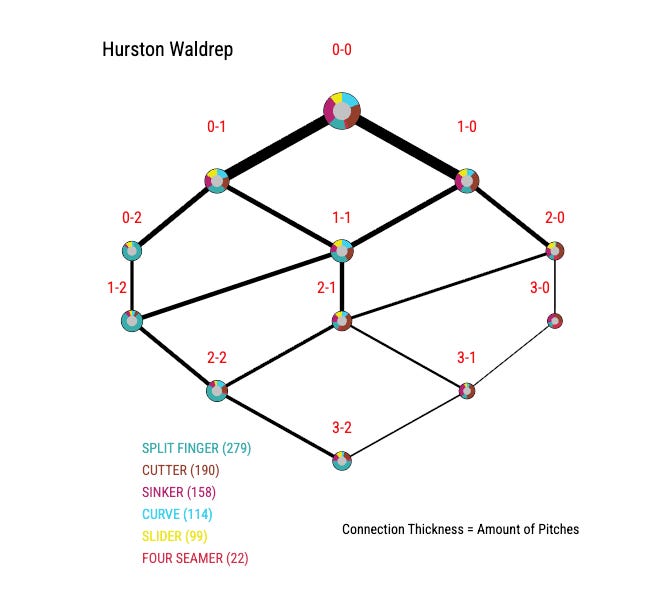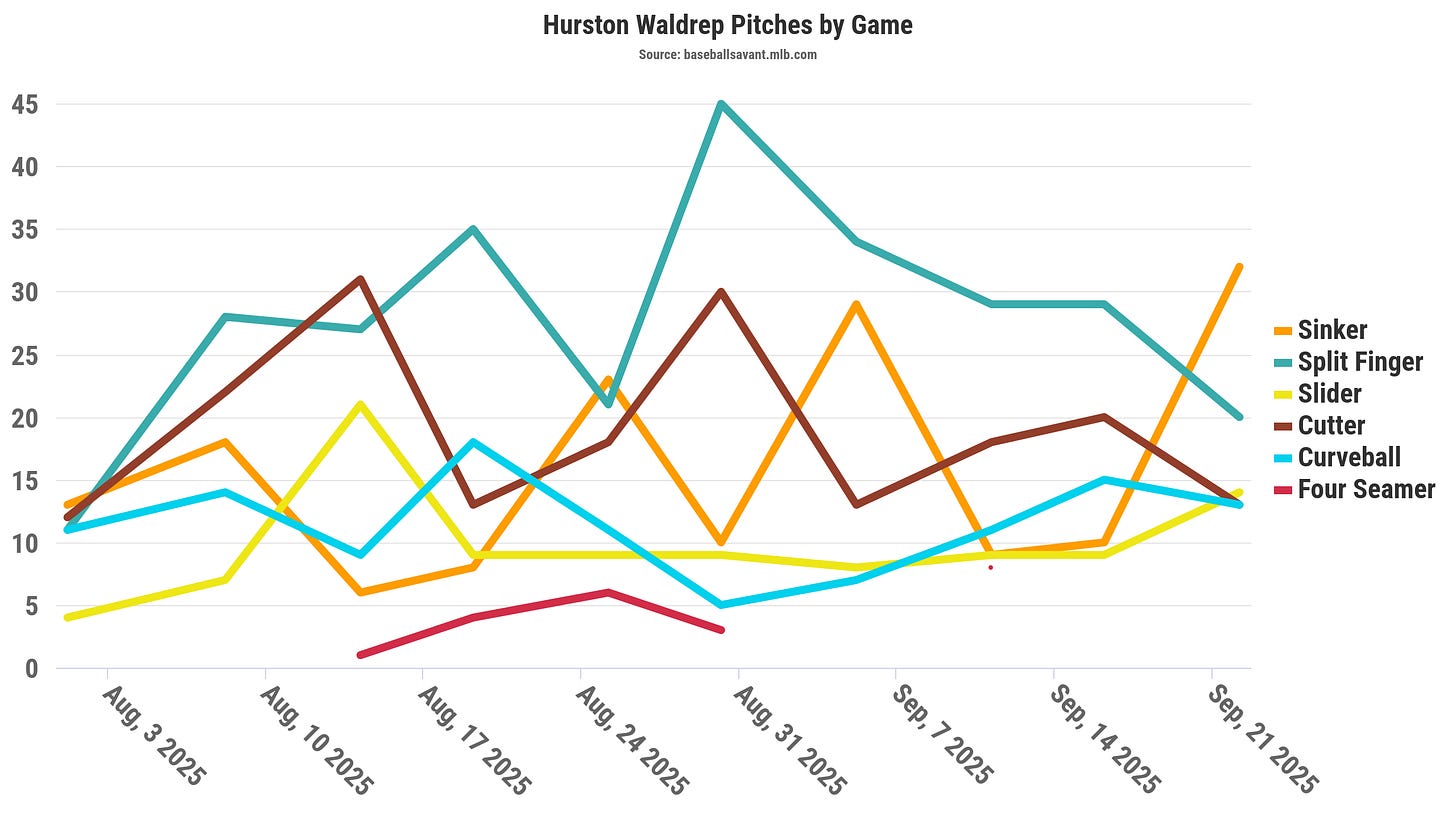Can Hurston Waldrep Take That Next 'Leap' in 2026?
The splitter’s already elite and now it’s time to find the rest of the formula.
(Today’s newsletter is inspired by ArmchairAlex, who responded to yesterday’s newsletter and podcast with a question about my classification of Hurston Waldrep as a potential playoff starter. His newsletter is really good and you should go subscribe!)
Atlanta Braves starter Hurston Waldrep had himself a year. Coming off a rough 2024 season, one where he stumbled in his major league debut (13 runs and eight walks in seven innings across two starts) and then went on the injured list with an elbow issue, expectations were not very high for the ‘Mayor of Splitter City’ entering 2025.
Those struggles largely led him to fall out of the #1 or #2 spot he was holding on several prospect lists after being taken as a first-rounder in the 2023 MLB Draft. Both Baseball America and FanGraphs had him as the organization’s #6 prospect prior to the season, with some openly questioning how long Atlanta would continue to try and chase his poor control before they shifted him into the pen.
And yet, a 2.88 ERA in a ten-game stretch in the majors, one in which he threw 61% strikes and had seven games with two or fewer walks (and four with one or none), has a lot of people changing their tune, myself included.
But, after just twelve starts in the majors, does he deserve to be considered a playoff-caliber starter? Let’s talk about it.
What did he do to improve?
He developed as a pitcher, that’s what.
To briefly recap, there were two major changes for Waldrep that changed the trajectory of his career - adjusting his mechanics and adding more pitches to his arsenal, one that was driven by his fastball/splitter pairing.
The first, the mechanical change, we broke down back in early May: Waldrep significantly lowered his leg lift and worked to redirect some of the lateral movement in his delivery towards the plate.
The second, expanding his arsenal, we covered in early August: Adding both a sinker and a cutter allowed him to minimize usage of his four-zone fastball, which suffered from an extremely dead-zone shape. Not overexposing any one fastball meant that they were all, in general, less hittable.
The combination of these two changes, which not only allowed him to throw more strikes and avoid walks but also get ahead of batters so that the splitter could work to maximum effectiveness, allowed him to come up to finish the Speedway Classic and stay in the majors for the rest of the season.
But are they enough to consider Waldrep a playoff-caliber starter? (The specific question we were asking yesterday was ‘Would I let this guy start game three of a playoff series for my team?’. For Waldrep, I said I would.)
Let’s break down why I had him there, as well as reasons to think that might be a bit premature.
The case for Waldrep in the playoffs
There are a few reasons why I’m a believer that the Waldrep we saw at the end of the year could get you through a playoff game three without completely tanking the team’s chances of winning the game.
The first is the caliber of his stuff. Waldrep had a strikeout rate near or better than 25% on four different pitches this season. The splitter carried the day at an absurd 45.4% Whiff%, followed by the curveball (38.7%), the four-seamer at 25%, and the slider at 24.5%. Former MLB pitcher Trevor May has discussed getting to 25% whiff on three pitches as the mark of a strikeout pitcher. We know the splitter is good, but having two other breaking balls at or near that mark as well as the ‘worst’ of his three fastballs (the four-seamer) means that he’s achieving those whiffs partly due to good sequencing and location, not just the quality of the stuff.
Another reason to be optimistic about Waldrep's ability to compete in October is his history of being able to stack workload - remember, one of the things we talked about yesterday is being able to get enough of your frontline starters to the postseason. Waldrep has a history of more than respectable innings totals, showing the ability to push himself year over year. After 90.0 innings his sophomore year at Southern Mississippi, he transferred to SEC powerhouse Florida and went all the way to the College World Series, throwing 101.2 innings and being up from January through June. Not to be deterred, however, he then went into Atlanta’s minor league system after the draft and led all 2023 draftees in both innings (29.1) and strikeouts (41), finishing the year with 131 innings. In 2024, owing to the elbow injury that came up after his second major league start, he managed ‘only’ 100 innings, but he was able to push that total all the way to 148 between Gwinnett and Atlanta in 2025. With some smart load management1, Waldrep can realistically get to 165 innings in the 2026 regular season, a figure which would qualify him for the ERA title on league leaderboards, while still having a bit more in the tank for October.
The third reason, and perhaps the hardest to quantify, is how he improved last season. The mechanical changes were supposedly spurred by a disastrous start to the season, one in which he had a 7.04 ERA and 18 walks in his first 23 innings. He didn’t make it out of the first inning once, leaving another start in the fourth and never making it past the fifteenth out of the contest. The sinker’s addition was thanks to MLB catcher Sean Murphy, who suggested it in passing to Waldrep while in Gwinnett, rehabbing his rib injury that delayed his season debut. Given how quickly Waldrep was able to adjust some fundamental parts of his delivery and his pitch mix, it makes you imagine he’s open to other significant changes if the need arises.
It’s not all upside, though
That proclivity for significant and rapid improvement may be needed, though, as we saw Waldrep stumble a bit during his ten-game MLB sample as scouting reports were updated for his new game plan on the mound.
The Houston Astros tagged Waldrep for eight runs on eight hits in less than five innings on September 12th, prompting me to write “the scouting report is out.” Essentially, it’s a race to get to two strikes for Waldrep, where his splitter becomes maximally effective and he can elicit all the whiffs his statline desires. Houston did a great job of getting to Waldrep early in their at-bats, taking advantage of a poor control night for the youngster to ambush early strikes and turn them into hard-hit balls while mostly neutralizing the split by just…not letting him get to two-strike counts.
Drilling down to a finer level, we can see how his strategy is contingent on the splitter working. Per Statcast, Waldrep was actually not that great at getting chase, coming in at an 8th-percentile mark of 24.5%. Some of this is stuff, and we’ll get to that, but some of that is approach. Again, his goal is to get to two strikes and then unleash the splitter.
Statcast has a feature called “Pitcher Plinko”, where they use a graphic to show a pitch distribution per count.
Waldrep, as you can see from the placement of the teal color that represents the split finger, is heavily reliant on the splitter in all two-strike counts (0-2, 1-2, 2-2, 3-2) but outside of 0-1 and 1-1, it falls back into 2nd or 3rd (or lower) in his usage chart. When he’s significantly behind in the count, it’s practically shelved, with Waldrep relying almost exclusively on his fastballs in 3-0 and 3-1 counts and pretty heavily in 2-0.
I still don’t know if we’ve seen a large-scale adjustment by opponents to this pitch usage trend, but I imagine it’ll come up rather early in 2026. Does he try and take advantage of a hitter’s early aggressiveness by getting him to chase a split on 0-0 or 1-0, or does he ramp up usage of the curveball and slider in his prototypical splitter counts? It’s a chess match, and opponents have likely made one move, if any, so far against Waldrep.
But on the other note from when we discussed the chase, some of this does come down to just the quality of his stuff. While yes, he has good Stuff+ (and whiff rates) on several of his breaking pitches, the actual fastballs are metrically pedestrian and not very lethal on their own. The sinker (93) and cutter (91) are fine, but the four-seamer continues to be one of the worst in baseball at just a 76 despite an average velocity of nearly 96 mph. We can see in his pitch usage that the four-seamer lagged the pack in usage and he practically stopped throwing it after August 31st (except for that disastrous Astros start, where he was just looking for anything that was working).
I appreciate how he oscillates between the sinker and the cutter, not relying on just one but rather varying which one is his primary based on matchups and what might be working that day. Keeping that variance in the game plan will help opponents from being comfortable in the box and prevent them from ambushing him early in at-bats.
While there’s reason to be pessimistic about the coming ‘sophomore slump’, there’s still legitimate reason to be excited, and I ultimately think he’ll end up being a playoff-quality starter next season.
A six-man rotation or building in extra rest plus pushing him back from time to time. Per a source, Waldrep was open to and had a discussion with Braves officials about a six-man rotation to end the season.





Baseball America writer Carlos Colozzo evaluated the Braves draft class today Oct 29.
For a change there are hitters and speedy runners not seen in the past half-dozen drafts.
I have a question for Lindsay.
For years i have argued the Braves have a geographical advantage with the international latin free agents.
Closer to the Caribbean and South America.
And all our farm teams are in the warm South.
Fans of other teams dispute me. Usually saying jet travel evens evrtything out.
I would like to hear some comments.